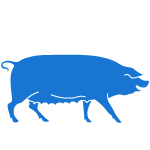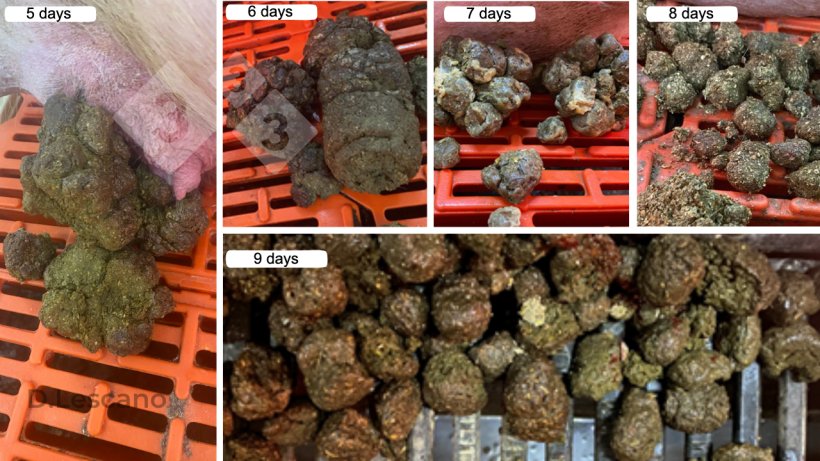Nutrition and feeding can both positively and negatively influence the challenge of constipation. It is important to keep in mind that this topic can have a synergistic interaction with other disciplines, such as management.
Causes and factors of constipation
Constipation is one of the major challenges facing hyperprolific sows today. It is characterized by difficulty passing feces or low frequency of defecation, resulting in the formation of hard, dry feces. The main underlying causes of this problem are detailed in Figure 1.

 |
Diet:
|
 |
Hydration:
|
 |
Physical activity:
|
 |
Hormones: Stress can trigger hormonal changes that can affect intestinal motility associated with:
|
Determining the incidence of constipation
If we wish to assess our farm's current situation and determine the incidence of constipation it is essential our methodologies are repeatable, simple, and can be applied practically on commercial farms.
Some options for these techniques are listed below:
| Scoring value ranging from 0 to 5 | |||||
| subjective technique | |||||
 0: absence of feces |
 1: dry and pellet-shaped |
 2: dry to normal |
 3: normal to soft, but solid and well-formed |
 4: normal to moist, still formed but not solid |
 5: very moist, misshapen and liquid |
| Ash profile in fecal matter, % | |||||
| complex technique | |||||
| Provide an inert and indigestible material (aluminosilicates) to the sows and take fecal samples twice daily. Perform ash analysis in the laboratory stove looking for increased ash in the fecal material. | |||||
| Hours from farrowing to first fecal matter | |||||
| simple objective technique | |||||
| The farrowing crates should be kept clean with no visible fecal matter. Record the day/time the first visible fecal matter is observed. | |||||
The methodology used in applied research trials done on commercial farms is the third technique. This technique allows an objective value to be established, i.e., the hours a sow takes to defecate after farrowing, for subsequent mathematical analysis.
Photo 1 shows the different consistencies of the feces in relation to the days elapsed from farrowing until the sow defecates. It can be seen that the longer the sow takes to defecate, the greater the hardness and consistency of the feces.

Photo 1. Visual appearance of feces from constipated sows.
Trials on multiple farms in several countries in Latin America and Europe have allowed an extensive database to be built that shows that the problem is more common than is often perceived.
The following is a summary of the 10 most significant effects observed on the farms evaluated over the last two years.
| 1 | Hours from farrowing to first fecal matter Sows took an average of 76 hours to defecate for the first time post-farrowing. |
|---|---|
| 2 | Incidence of constipation Seventy percent of the sows took more than 48 hours to defecate after farrowing. |
| 3 | Incidence of constipation in gilts Eighty percent of the gilts took more than 48 hours to defecate after farrowing. |
| 4 | Farrowing duration Constipated sows have a longer farrowing duration. |
| 5 | Rectal temperature Increased rectal temperature in constipated sows. |
| 6 | Total losses at birth (TL%) TL% at farrowing (stillbirths and mummies) increased by over 30%. |
| 7 | Colostrum quality (degrees Brix %) Lower colostrum quality, observing 7% lower degrees Brix (indirect measurement of IgG). |
| 8 | Feed intake (FI) Constipated sows have a 10% lower FI during lactation. |
| 9 | Body condition As a consequence of the lower FI, there is a marked increase in the loss of body condition. |
| 10 | Pelvic organ prolapse (POP) - MMA Favors the incidence of POP as well as mammary edema and mastitis. |
Intervention tools to reduce this challenge
- Data logging and monitoring: Keeping detailed records of sow health and behavior as well as parameters related to feeding, hydration, and management, can provide valuable information for identifying trends and proactively adjusting constipation prevention strategies.
- Transfer of sows to farrowing rooms: It is crucial this process is done calmly and smoothly to minimize stress that could affect the normal activity of the digestive function.
- Maximize quality water consumption: On many farms, the water supply system in gestation differs from that used in the farrowing rooms which can result in decreased hydration during the first few days after moving sows to the farrowing room. It is critical to ensure adequate water flow at times when all sows are feeding and also to ensure the quality of the water offered.
- Feeding routine: Ensuring regular and frequent feed intake and avoiding long fasting periods in sows is essential to improve their digestive function.
- Perifarrowing diets: Customized diet design in this period is vital. This approach involves the meticulous combination of ingredients as well as nutritional and non-nutritional additives to address the specific challenges faced by each farm.
- Fiber use: Fiber plays a crucial role in preventing constipation in pigs by promoting intestinal motility, water retention, and consequent proper feces formation. Although progress has been made in understanding its benefits, challenges remain in optimizing its use and dosage for each stage, underscoring the need for further research to improve its implementation and maximize its impact on the gastrointestinal integrity and health of pigs.
- Use of probiotics: The use of active yeasts as probiotics has been shown to have a positive impact on reducing constipation in sows. These yeasts promote a balance in the intestinal flora, improving digestion and gastrointestinal motility.
- Use of magnesium sulfate: Its laxative effect lies in its ability to retain water in the intestine, which softens the feces and facilitates its elimination. Dosage and frequency of application should be adjusted according to the specific needs of each farm. This ingredient is an effective and economical tool to implement on commercial farms.
These are the main options available that have been successfully implemented on commercial farms. It is important to note that, as in any aspect of production, there are no magic bullets. Therefore, it is recommended that each farm validate these tools by developing applied research trials, using a particular experimental design for their specific situation.
This approach will allow for greater precision in selecting and combining strategies, which in turn will contribute to improving animal welfare, productivity, and, consequently, profitability on swine farms.



